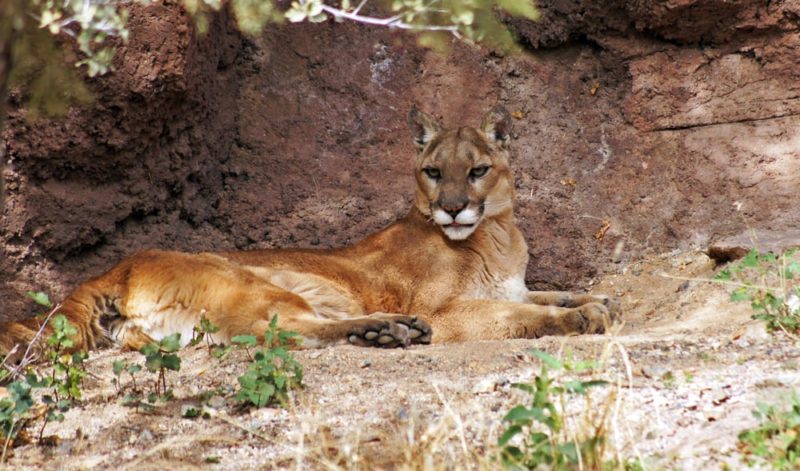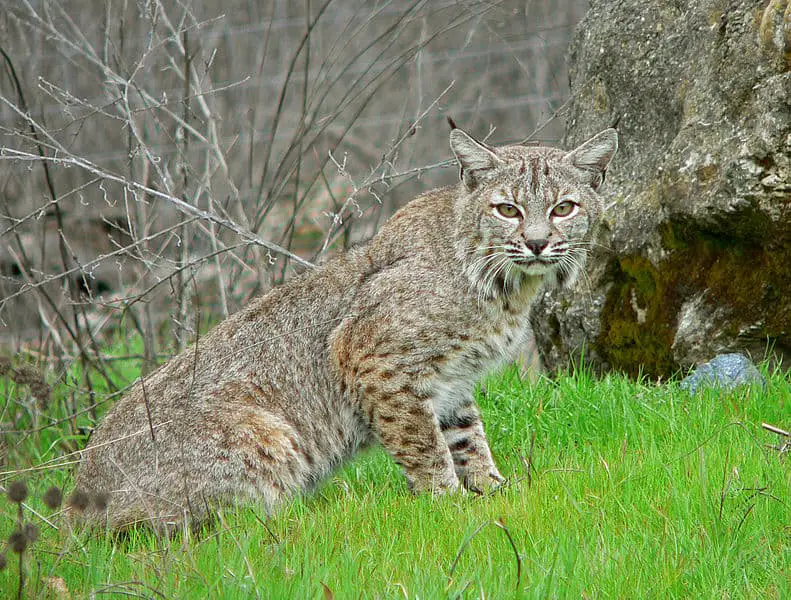Despite some Georgia residents claiming mountain lion and black panther sightings, the Georgia Department of Natural Resources maintains that the only species of wild cat in the state is the Bobcat.
Bobcats in Georgia (Lynx rufus)
The bobcat, which is also known as the red lynx, or the bay lynx, is exclusively a North American wild cat. They are also the most common wild cat species in North America.
Other than feral cats, bobcats are likely the only feline predator with a breeding population within the state of Georgia.
Biologists believe that both the bobcat and the Canada lynx are descendants of the Eurasian lynx whose ancestors crossed into North America via the Bearing Sea land bridge.
Where do bobcats live?
Bobcats reside only in North America. Their range begins in southern Canada and then extends south through most of the United States and down into central Mexico.
In Georgia, bobcats live in most areas of the state. People rarely see them, though, because they are mostly a crepuscular or nocturnal animal.
Compared to Canada lynx, which thrive in deep snow country, bobcats struggle more in the snow due to the fact that they cannot walk on top of it like lynx can. A lynx’s oversized large paws function like snowshoes keeping it on the snow’s surface. On the other hand, compared to lynx, bobcats have small feet that tend to sink into the snow. If the snow is too deep and powdery, it reduces their mobility along with their ability to catch prey.
Admittedly, snow is almost never an issue in Georgia. The commentary on snow is still important in establishing the bobcat’s broader range over the entirety of North America.
Other than their inability to cope with deep snow, bobcats are pretty versatile and tend to utilize all the different habitats within their range. You can find bobcat populations anywhere, from areas with coniferous forests to swamps and semi-forested mountain areas. You’ll even find them in agricultural areas and or urban areas.
In the peach state, bobcats typically inhabit mixed forest and agricultural areas that have a high percentage of early successional plant species.
Bobcats are solitary animals with the exceptions of during mating season or when a female is raising young. They are territorial and live in home ranges that they patrol and scent mark with urine and feces.
In Georgia, the home range of a male bobcat can be over 10 square miles, while female bobcat home ranges can be less than 1 square mile. One more thing about home ranges is that adult males and adult females sometimes have overlapping ranges.
Bobcats often use rock crevices as den sites but may also den in the cavity beneath an overturned stump or beneath a blown-down tree,

What do bobcats look like?
An adult bobcat is a bit larger than a large domestic cat, like a Maine coon cat, for instance.
They range from 2 to 3 feet long and weigh from 15 to 35 pounds. Adult male bobcats are quite a bit larger than females.
These animals have “bobbed,” stubby tails with black bands on their upper surface. Their tail also has a black tip on its upper surface but not the back. Their fur is usually gray to brown, with mottled black spots interspersed with black lines on their bodies. They also have black stripes on their inner forelegs and tail.
From a side view, you will notice that a bobcat is slightly higher at the rump than at the shoulders. Bobcats and lynx have long hind legs in proportion to their forelegs.
Bobcats have black-tufted, proportionately large ears. In other words, they have short ear tufts of hair that poke up above their ears that are black at the tips. The backs of their ears, below the black tips, are black. In the center of the black of each ear, they have a single white spot. This gives the impression of a false eye on the back of each ear.
They also have a whiskered face that seems broader due to their long ruffled facial hair and whiskers. Their eyes are yellow with round black pupils.
What do bobcats eat in Georgia?
Despite their comparatively small size, bobcats are aggressive, tough predators. At times, particularly during the winter, they take down wild animals that are several times larger than they are, such as feral hogs and white-tailed deer. However, their regular diets mainly consist of smaller animals such as eastern cottontails, swamp rabbits, eastern gray squirrels, and assorted rodents. They also eat reptiles, birds, insects, and carrion. When they take up residence close to a residential area, their menu might occasionally also include small pets or small livestock such as goats or chickens.
They even use venomous snakes as a food source when the opportunity arises despite not being immune to the venom. They accomplish this by using their quickness to pin the snake’s head down with a paw, after which they dispatch the snake with a quick bite to its spine behind the head.
Reproduction and life cycle for bobcats
Bobcats mate anywhere in February and March. During the breeding season, a male bobcat may mate with multiple females. If they successfully mate, the gestation period for bobcats is 60 days.
After breeding, the male and female go their separate ways. The female takes all responsibility for the selection of a den site and the rearing of the young. Females generally give birth between late April and early May. See
The average bobcat litter size is 3 kittens. Bobcat kittens are born with their eyes sealed, just like domestic cats are. However, their eyes will open when they are a week to 10 days old. By the time they are 2 months old, they will have replaced their spotted baby fur with a haircoat similar to what their parents have.
By mid-July, the kittens begin to venture out with their mothers to fine-tune their survival skills. Their training may last into the early winter. By mid-winter, the kittens strike out on their own.
Female bobcats reach sexual maturity at 1 year of age, while males reach sexual maturity at age 2.
In the wild, the average life span of a bobcat is 7 to 10 years. See

Are there mountain lions in Georgia?
Mountain lions are native to Georgia. According to Charlie Killmaster, who is a wildlife biologist with the Georgia DNR, the eastern cougar historically ranged through much of the state. See, They’re gone now, though, and have been since the early 1900s. The last known eastern cougar was killed in Maine in 1938, and in 2018 the U.S. Fish and Wildlife Service declared them to be extinct.
According to the Georgia DNR, although there have been 3 credible mountain lion sightings in the last 25 years, there is no evidence of a breeding population of the big cats. Evidence would include such things as mountain lion carcasses, tracks, scat, trail camera pictures, photographs, and film footage.
The closest population of mountain lions to Georgia is located southwest of Lake Okeechobee in South Florida. In Florida, they call them panthers. Occasionally a Florida panther will wander north into southern Georgia.
In 2008, David Adams was hunting deer in Troup County when he killed a wild panther that had wandered up from Florida. Before that, the last confirmed wild Florida panther was killed in the Okefenokee swamp in 1925.
Mountain lion range and characteristics
Mountain lions have several different common names that are interchangeable. The name that humans give them depends on the geographic region. Some of the names that people in different parts of the United States give these animals include cougar, puma, and Florida panther.
Mountain lions are the most widely distributed species of wild cats in the Americas. Their range extends from the Yukon territory in Canada down through parts of North America, Central America, and South America. The southern boundary of their range is Patagonia.
Most of North America’s mountain lion population is largely confined to the western U.S. and western Canada.” They are considered to be extinct in the eastern United States, with the exception of southern Florida.
These are large cats and apex predators. In fact, they are the 4th largest wild cat in the world behind the tiger, the African lion, and the Jaguar. However, despite their large size, they are not taxonomically classified in the (Panthera) genus with big cats. This is because they lack the ability to roar. Instead, they are in the (Felis) genus. Jaguars are the only species of big cats in the western hemisphere.
Male and female mountain lions are phenotypically identical, except in size. Typically, males are 30 to 40% bigger than females. Though sizes vary considerably throughout the cat’s geographic range, an adult male typically weighs between 110 and 180 pounds (49.89 to 81.64 kgs).
Additionally, adult males or toms will reach a length of 6 to 8 feet (1.82 to 2.43 m) from the snout to the tip of the tail, while females or queens will reach 5 to 7 feet (1.52 to 2.13 m). In weight, females average between 80 and 130 pounds (36.28 to 58.96 kg). A few adult toms surpass 200 pounds (90.71 kg).
The appearance of a mountain lion is that of a giant, tan slick haired house cat. These animals, in general, have lean, sinewy bodies, somewhat rounded heads, and upright, round-tipped ears. The short, coarse hair that covers most of their body is light tan to brown. They have a long tail which is almost a third of their entire length. Black is the color of the tip of their tail, their ears, and the area around their nose. Conversely, their belly, the area above their upper lip, below their lower lip, and their chin are all white. They also have a sprinkling of black hair on their backs. Their hair color varies somewhat with geographic location.
Mountain lion kittens or cubs (either word is acceptable) have camouflaging patches and rings around their tails that gradually fade away as they mature. All of their camouflage markings will be gone by the time they’re six months old.
Are there black panthers in Georgia
The Georgia DNR receives reports of sightings of black panthers within the state from time to time. Unlike with cougar sightings in the state, there is absolutely no credible supporting evidence to back such claims. Black panthers are actually melanistic leopards or jaguars. Leopards live in Africa and Asia. On the other hand, Jaguars do live in the Americas, from northern Argentina in the south to the Desert southwest of the United States in the extreme north. Black jaguars do exist, but the existence of a black jaguar in Georgia has never been established.
Black panthers in Georgia are not 100% out of the realm of possibility. However, some more likely culprits for these sightings are black bears, black labs, and perhaps even a black ordinary housecat or two thrown in for good measure.
Recent Posts
The only venomous snakes in Washington State are Northern Pacific Rattlesnakes. The Northern Pacific Rattlesnake (Crotalus oreganus oreganus) is a sub-species of the Western Rattlesnake. Anyone...
Skunks are not classified as true hibernators. But they go into a state of torpor when the weather gets cold. Skunks are light sleep hibernators, along with opossums, bears, and raccoons. ...

